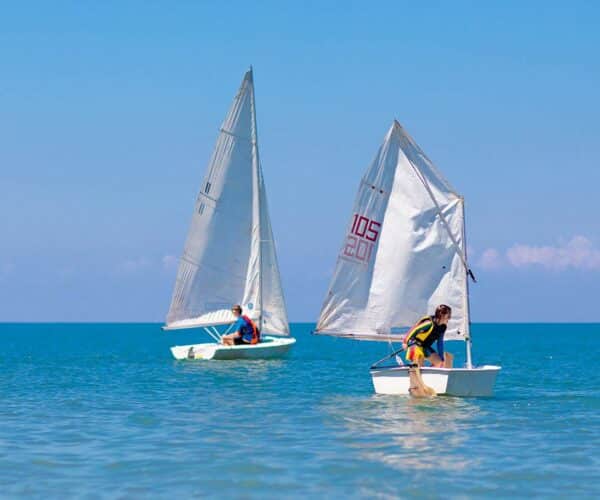If you’ve ever dreamed of feeling the wind in your hair and the spray of the sea on your face as you glide across the water, then sailing could be your next adventure. Sailing is a fantastic blend of thrill and tranquillity, where every day on the water brings new challenges and unforgettable moments. Whether you’re drawn to the serene beauty of a calm lake or the invigorating splash of coastal waves, the world of sailing has something for everyone.
If you’re sailing for the first time, whether you’re planning to learn the ropes close to home or hoping to navigate the turquoise waters abroad, we’ve got you covered. From choosing the right sailing course to mastering basic techniques and understanding essential safety tips, our guide is packed with all the info you’ll need to set sail with confidence.
Preparing for your first sail

Choosing the right sailing course
Need to know how to tell your port from starboard? That’s where formal training comes in, and it’s absolutely essential. Not only does it keep you safe, but it also makes your time on the water way more enjoyable.
In the UK, you’re spoiled for choice with fantastic sailing schools like the UKSA and the Royal Yachting Association (RYA), which offer top-notch courses. Whether you’re aiming for a basic Competent Crew certificate or eyeing more advanced qualifications like the Day Skipper, there’s something for every level.
If you’re feeling adventurous and want to sail under sunnier skies, schools abroad like Sunsail in Greece or the British Offshore Sailing School in the Caribbean are excellent options.
What to wear and bring
Before you hit the waves, let’s talk wardrobe. Dressing the part is not just about looking stylish but staying safe and comfy. First off, you’ll need a good waterproof jacket and trousers – staying dry is a game-changer. Layer up with quick-dry clothing because the sea breeze can be nippy.
Don’t forget non-slip shoes to keep you steady on deck. A life jacket is a must, but the sailing school will usually provide one. As for accessories, pack a hat, sunglasses (with a strap to avoid a watery grave), and plenty of suncream. And don’t forget your sailing gloves; they’ll save your hands from rope burns. Stash some snacks and a water bottle in your bag to keep your energy up. With the right gear, you’ll be ready to sail in style and comfort.
Understanding basic sailing terms
Ready to dive into the world of sailing lingo? Don’t worry, it’s easier than it looks! Let’s start with the basics: “port” is the left side of the boat, and “starboard” is the right. The front of the boat is called the “bow,” and the back is the “stern.” Got it? Great!
Now, on to some essential parts of the sailboat: the “mast” is the tall vertical pole that holds the sails, the “boom” is the horizontal pole at the bottom of the sail, and, of course, the “sails” catch the wind and propel you forward.
When it comes to moving your boat, you’ll need to master “tacking” (turning the bow through the wind) and “jibing” (turning the stern through the wind). Understanding these basic manoeuvres is crucial for navigating the waters.
Equally important is wind awareness; knowing the wind’s direction and speed will help you sail smoothly and safely. With these terms and concepts under your belt, you’ll be ready to set sail confidently and enjoy your time on the water. Basic principles of sailing into the wind (tacking) and with the wind (running).
On the water tips

Safety first
Once you’re on the water there are some significant tips to ensure you have a smooth and safe journey.
First things first: safety. Always wear a life jacket – it’s non-negotiable. Make sure you know where all the safety equipment is stored, like flares, fire extinguishers, and first aid kits.
In case of an emergency, stay calm and follow the basic safety procedures you’ve learned: signal for help, use your emergency equipment, and stay with the boat. Safety drills might seem tedious, but they’re lifesavers.
Basic sailing techniques
Handling the boat is where the real fun begins. In calm waters, practice steering and trimming the sails to get a feel for how your boat responds. When the waters get a bit choppy, keep your cool and adjust your sails to manage the wind and waves.
Mastering simple manoeuvres like tacking (turning the bow through the wind) and jibing (turning the stern through the wind) will make you feel like a pro in no time. Remember, practice makes perfect, so take your time to learn and enjoy the process.
Reading the weather
Always check the weather forecast before you set sail. Knowing what to expect can make the difference between a pleasant day on the water and a challenging ordeal. Learn to interpret common weather signs: dark clouds usually mean a storm is brewing, while steady winds are ideal for sailing. Pay attention to wind direction and speed, as they’ll guide your decisions on the water. A good sailor is always aware of the weather and ready to adapt.
Developing your skills
Now that you’ve dipped your toes in the water, it’s time to level up your sailing game. Here are some friendly tips to help you become a seasoned sailor.
Joining a sailing club
Sailing clubs offer a treasure trove of benefits: access to boats, regular sailing events, and a community of fellow sailing enthusiasts. Plus, there’s nothing like swapping sea stories with new friends over a post-sail pint.
To find the perfect club in the UK, check out the RYA website or ask around at your local marina. Look for clubs that offer beginner-friendly programs and a welcoming atmosphere. You’ll soon find yourself part of a tight-knit crew, ready to embark on countless sailing adventures.
Practicing regularly
Consistency is key when it comes to mastering sailing. Aim to practice regularly, whether it’s a leisurely sail on a local lake or a more challenging outing along the coast. Local lakes are great for honing your skills in a controlled environment, while coastal areas offer the thrill of open waters. The important thing is to get out there and sail as often as you can. Each trip will boost your confidence and refine your techniques.
Learning from others
One of the best ways to accelerate your learning is by tapping into the wisdom of experienced sailors. Seek out mentorship opportunities within your sailing club. Many seasoned sailors are more than happy to share their knowledge and tips.
Participating in group sails and events is another fantastic way to learn. You’ll pick up new skills, gain insights into different sailing styles, and make new friends along the way. Plus, it’s always more fun to sail with a crew!
Where to learn to sail for beginners

Whether you’re looking to sail the serene waters of the UK or venture to more exotic locales, there are fantastic spots perfect for beginners. Here’s your guide to some of the best places to get started.
Sailing Spots in the UK
The UK is blessed with a plethora of amazing sailing spots that cater to all skill levels. Here are a few top picks:
The Solent
Known as the sailing capital of the UK, the Solent offers sheltered waters and a vibrant sailing community. It’s an ideal spot for beginners, with plenty of sailing schools and clubs.
Lake Windermere
The largest lake in England, Lake Windermere is perfect for those who prefer a tranquil setting. Its calm waters and stunning scenery make learning to sail here a delight.
Falmouth Bay
Located in Cornwall, Falmouth Bay offers a mix of sheltered waters and open sea, providing a great training ground for beginners.
Scottish Lochs
For a unique experience, try sailing in the Scottish lochs. Loch Lomond and Loch Ness offer beautiful, sheltered waters that are perfect for novices.
Sailing abroad
If you’re feeling adventurous and want to learn to sail under sunnier skies, here are some top international destinations for beginners:
Greek Islands
Greece is renowned for its crystal-clear waters and gentle winds. The Saronic Gulf and Ionian Sea are particularly popular for novice sailors.
Croatia’s Dalmatian Coast
With its calm seas, beautiful islands, and historic towns, Croatia is a fantastic place to learn to sail. The Adriatic Sea offers ideal conditions for beginners.
Caribbean
The Caribbean is a sailor’s paradise with its warm waters and consistent trade winds. Locations like the British Virgin Islands are perfect for beginners, offering plenty of sheltered bays and expert sailing schools.
Useful Resources for novice sailors

Online Learning and Resources
RYA eSailing
The RYA offers online courses and e-learning modules covering various aspects of sailing, from basic navigation to advanced techniques.
YouTube Channels
These channels offer a mix of educational content and inspiring sailing adventures, perfect for beginners looking to learn and be motivated.
Sailing Clubs and Associations
Royal Ocean Racing Club (RORC)
Joining a club like RORC can provide you with access to races, training events, and a network of experienced sailors.
Local Sailing Clubs
Search for sailing clubs in your area using the RYA’s club finder: RYA Club Finder
Joining a local club can give you access to boats, regular sailing sessions, and a supportive community.
Weather and Navigation Tools
Met Office
Stay up to date with the latest weather forecasts for coastal and marine areas.
Navionics
A popular app and website, Navionics, for nautical charts and navigation.
Get Sailing Insurance with SportsCover Direct
Another essential thing to consider before a sailing trip, whether in the UK or abroad, is insurance cover. Sailing can be an exhilarating adventure, but it isn’t without its risks; furthermore, if you need rescue or medical help, being abroad can make things much more complicated and expensive.
SportsCover Direct is a leading provider of specialist sailing insurance for sailing trips, both in the UK and abroad. Our cover means that if you get ill, get injured, require rescue assistance, suffer transport disruption, or your luggage is lost, we can give you support that means you won’t be left out of pocket.
Included with our policies is cover for any private medical bills you might incur this is a vital consideration, as the European and Global Health Insurance Cards only extend to a limited level of healthcare.
Find out more here.
This blog has been created as general information and should not be taken as advice. Make sure you have the correct level of insurance for your requirements and always review policy documentation.